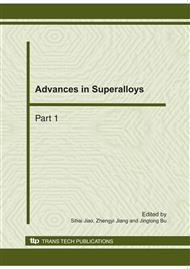p.980
p.987
p.991
p.996
p.1000
p.1004
p.1009
p.1013
p.1017
Hardness Test on an Epoxy Mold Compounds of a Quad Flat No Lead Package Using the Depth Sensing Nanoindentation
Abstract:
This study focuses on the effect of stress and load towards hardness at epoxy mold compounds (EMCs) of a Quad Flat No- Lead (QFN) package using indentation technique. A series of three points bending cyclic test were performed with four different loads between 60 N to 120 N on QFN package. The nanoindentation with the maximum load of 300 mN was indented at five locations that perpendicular to the stress line on EMCs of QFN package after three points bending cyclic test were performed. The findings showed that the mean value of hardness was varied with load and stress. Higher load and stress were found to be not affected by hardness of EMCs. From the results, it is believed that the applied load and stress not play a role towards the hardness of EMCs. A polynomial relationship was plotted and shown that correlation of coefficient (R2) between stress and hardness of the studied EMCs was found to be at 97%. Finally, the finding suggested that a close correlation between the stress and hardness since it correlation coefficient gave a higher value with the polynomial relationship.
Info:
Periodical:
Pages:
1000-1003
Citation:
Online since:
October 2010
Keywords:
Price:
Сopyright:
© 2011 Trans Tech Publications Ltd. All Rights Reserved
Share:
Citation:


